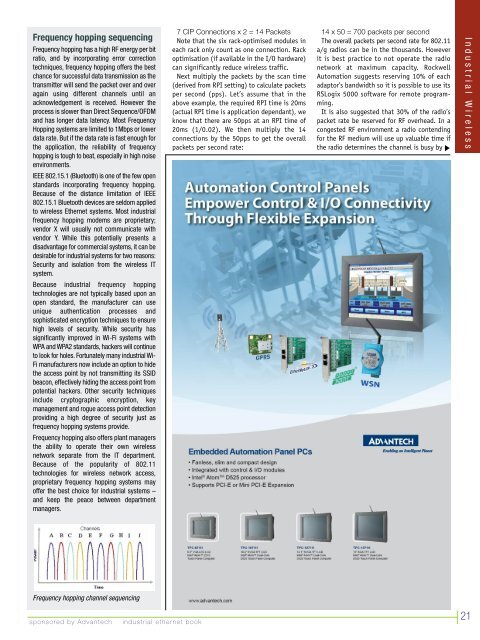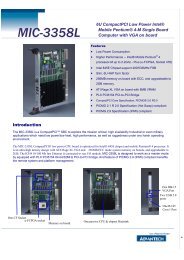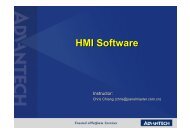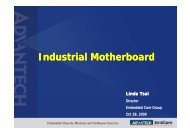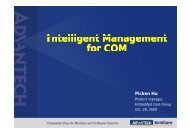industrial wireless book special edition - Networking ...
industrial wireless book special edition - Networking ...
industrial wireless book special edition - Networking ...
Create successful ePaper yourself
Turn your PDF publications into a flip-book with our unique Google optimized e-Paper software.
Frequency hopping sequencing<br />
Frequency hopping has a high RF energy per bit<br />
ratio, and by incorporating error correction<br />
techniques, frequency hopping offers the best<br />
chance for successful data transmission as the<br />
transmitter will send the packet over and over<br />
again using different channels until an<br />
acknowledgement is received. However the<br />
process is slower than Direct Sequence/OFDM<br />
and has longer data latency. Most Frequency<br />
Hopping systems are limited to 1Mbps or lower<br />
data rate. But if the data rate is fast enough for<br />
the application, the reliability of frequency<br />
hopping is tough to beat, e<strong>special</strong>ly in high noise<br />
environments.<br />
IEEE 802.15.1 (Bluetooth) is one of the few open<br />
standards incorporating frequency hopping.<br />
Because of the distance limitation of IEEE<br />
802.15.1 Bluetooth devices are seldom applied<br />
to <strong>wireless</strong> Ethernet systems. Most <strong>industrial</strong><br />
frequency hopping modems are proprietary;<br />
vendor X will usually not communicate with<br />
vendor Y. While this potentially presents a<br />
disadvantage for commercial systems, it can be<br />
desirable for <strong>industrial</strong> systems for two reasons:<br />
Security and isolation from the <strong>wireless</strong> IT<br />
system.<br />
Because <strong>industrial</strong> frequency hopping<br />
technologies are not typically based upon an<br />
open standard, the manufacturer can use<br />
unique authentication processes and<br />
sophisticated encryption techniques to ensure<br />
high levels of security. While security has<br />
significantly improved in Wi-Fi systems with<br />
WPA and WPA2 standards, hackers will continue<br />
to look for holes. Fortunately many <strong>industrial</strong> Wi-<br />
Fi manufacturers now include an option to hide<br />
the access point by not transmitting its SSID<br />
beacon, effectively hiding the access point from<br />
potential hackers. Other security techniques<br />
include cryptographic encryption, key<br />
management and rogue access point detection<br />
providing a high degree of security just as<br />
frequency hopping systems provide.<br />
Frequency hopping also offers plant managers<br />
the ability to operate their own <strong>wireless</strong><br />
network separate from the IT department.<br />
Because of the popularity of 802.11<br />
technologies for <strong>wireless</strong> network access,<br />
proprietary frequency hopping systems may<br />
offer the best choice for <strong>industrial</strong> systems –<br />
and keep the peace between department<br />
managers.<br />
7 CIP Connections x 2 = 14 Packets<br />
Note that the six rack-optimised modules in<br />
each rack only count as one connection. Rack<br />
optimisation (if available in the I/O hardware)<br />
can significantly reduce <strong>wireless</strong> traffic.<br />
Next multiply the packets by the scan time<br />
(derived from RPI setting) to calculate packets<br />
per second (pps). Let’s assume that in the<br />
above example, the required RPI time is 20ms<br />
(actual RPI time is application dependant), we<br />
know that there are 50pps at an RPI time of<br />
20ms (1/0.02). We then multiply the 14<br />
connections by the 50pps to get the overall<br />
packets per second rate:<br />
14 x 50 = 700 packets per second<br />
The overall packets per second rate for 802.11<br />
a/g radios can be in the thousands. However<br />
it is best practice to not operate the radio<br />
network at maximum capacity. Rockwell<br />
Automation suggests reserving 10% of each<br />
adaptor’s bandwidth so it is possible to use its<br />
RSLogix 5000 software for remote programming.<br />
It is also suggested that 30% of the radio’s<br />
packet rate be reserved for RF overhead. In a<br />
congested RF environment a radio contending<br />
for the RF medium will use up valuable time if<br />
the radio determines the channel is busy by<br />
I n d u s t r i a l W i r e l e s s<br />
Frequency hopping channel sequencing<br />
sponsored by Advantech<br />
<strong>industrial</strong> ethernet <strong>book</strong><br />
21


